Introduction
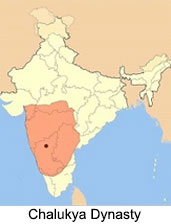 Chalukya Dynasty was a powerful Indian dynasty that reigned over extensive parts of southern and central India between the period of 6th and the 12th centuries. They had ruled their dominions as three individual yet related dynasties. The first one was the Badami dynasty who ruled from Vatapi. Then came the Eastern Chalukyas who ruled over Deccan. The Western Chalukyas ruled from Kalyani. The Badami Chalukyas became prominent during the rule of Pulakesin II. After his death the Eastern Chalukyas emerged as an independent kingdom and ruled eastern Deccan. In the western India, their descendents Western Chalukyas ruled in the late 10th century and reigned from Kalyani which is the present day Basavakalyan.
Chalukya Dynasty was a powerful Indian dynasty that reigned over extensive parts of southern and central India between the period of 6th and the 12th centuries. They had ruled their dominions as three individual yet related dynasties. The first one was the Badami dynasty who ruled from Vatapi. Then came the Eastern Chalukyas who ruled over Deccan. The Western Chalukyas ruled from Kalyani. The Badami Chalukyas became prominent during the rule of Pulakesin II. After his death the Eastern Chalukyas emerged as an independent kingdom and ruled eastern Deccan. In the western India, their descendents Western Chalukyas ruled in the late 10th century and reigned from Kalyani which is the present day Basavakalyan.
The rule of the Chalukyas was a milestone in the history of South India. The political atmosphere changed from small empires to large ones with the arrival of Badami Chalukyas. Efficient administration, overseas trade and commerce and the development of new style of architecture, all these were witnessed during the rule of the Chalukya dynasty. Kannada and Telugu literature received patronage from Western and Eastern Chalukyas respectively.
Origin of Chalukya Dynasty
Origin of Chalukya dynasty has had various theories attributed to it. The consensus is that the founders of the empire at Badami were native to the Karnataka region. According to one theory, they are descendants of the Seleukia tribe of Iraq. Their clash with the Pallavas was an extension of the fight between Seleukia and Parthians. The Chalukyas claim themselves as Harithiputras of Manavyasagotra in their inscriptions, whose lineage is same as their early overlords, the Kadambas of Banavasi. They took control of the territory formerly ruled by the Kadambas. A later record of Eastern Chalukyas claims that one ruler of Ayodhya came from south, defeated the Pallavas and married a Pallava princess. She had a child called Vijayaditya who was considered to be the father of Pulakesin I. However it was a common practice to link South Indian royal family ancestry to a Northern kingdom. The caste of the Chalukya dynasty has also been in controversies. Kashmiri poet, Bilhana, suggests that they were Sudras while others assert they are Kshatriyas.
Chalukyas of Badami
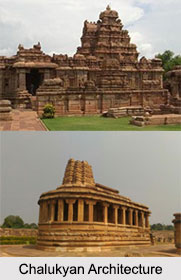 Chalukyas of Badami : Chalukya dynasty was established by Pulakesin I in 543. Vatapi was the capital and their domain consisted entirely of Karnataka and larger extent of Andhra Pradesh in the Deccan. He was the most popular ruler of Badami dynasty. He was succeeded by Pulakesin II who extended the empire to northern kingdoms of the Pallavas. The dynasty was on the verge of decline when Vikramaditya I recovered its glory partially. He was succeeded by Vijayaditya and subsequently by Vikramaditya II. The latter is known for various victories over major southern states. The last ruler was Kirtivarman II, who was overpowered by the Rashtrakutas. The Chalukyas ruled an empire stretching from the River Kaveri in the south to the River Narmada in the north.
Chalukyas of Badami : Chalukya dynasty was established by Pulakesin I in 543. Vatapi was the capital and their domain consisted entirely of Karnataka and larger extent of Andhra Pradesh in the Deccan. He was the most popular ruler of Badami dynasty. He was succeeded by Pulakesin II who extended the empire to northern kingdoms of the Pallavas. The dynasty was on the verge of decline when Vikramaditya I recovered its glory partially. He was succeeded by Vijayaditya and subsequently by Vikramaditya II. The latter is known for various victories over major southern states. The last ruler was Kirtivarman II, who was overpowered by the Rashtrakutas. The Chalukyas ruled an empire stretching from the River Kaveri in the south to the River Narmada in the north.
Western Chalukya Dynasty
Western Chalukya Dynasty : Vikramaditya IV is considered as one of the best ruler of Western Chalukya dynasty. Under his leadership the Western Chalukyas ended the Chola influence over Vengi and became the dominant power in the Deccan. Sanskrit and Kannada literature gained immense development during this time. Their decline started with the rise of Hoysalas, Pandyas and few other dynasties towards the end of 12th century.
Eastern Chalukya Dynasty
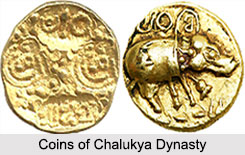 Eastern Chalukya Dynasty : After the death of Pulakesin II, Vengi developed into an independent territory. For many years the Chalukyas had to accept the suzerainty of the Rashtrakutas. It was during the rule of Bhima I that they ruled independently. The fate of the kingdom turned after Darnarnava, the Chalukya king was killed in a battle in 973. His two sons took refuge in Chola kingdom. Shaktivarman I, his elder son was crowned as the ruler of Vengi but it was overseen by Chola king Rajaraja Chola. The Eastern Chalukyas had encouraged Kannada language and literature, though, after a period of time, importance was given to Telugu language.
Eastern Chalukya Dynasty : After the death of Pulakesin II, Vengi developed into an independent territory. For many years the Chalukyas had to accept the suzerainty of the Rashtrakutas. It was during the rule of Bhima I that they ruled independently. The fate of the kingdom turned after Darnarnava, the Chalukya king was killed in a battle in 973. His two sons took refuge in Chola kingdom. Shaktivarman I, his elder son was crowned as the ruler of Vengi but it was overseen by Chola king Rajaraja Chola. The Eastern Chalukyas had encouraged Kannada language and literature, though, after a period of time, importance was given to Telugu language.
Chalukyan Architecture
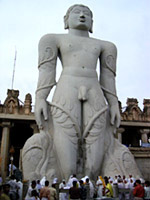 The Chalukyas of Badami left some of India`s most important rock-cut work and the architecture in Chalukya dynasty was influenced by the patterns of southern India. The Chalukyas, however, their fortunes restored, emerged immediately as vigorous patrons of architecture just like their ancestors. They took their influence south; moreover, to rival the Cholas in the domains of the western region of Ganga whose main sites are their capital, Talkad, and the Digambara Jaina centre of Shravanabelagola. Meanwhile the Eastern Chalukyas maintained their hold in the state of Andhra Pradesh and continued to construct in a separate hybrid style of architecture.
The Chalukyas of Badami left some of India`s most important rock-cut work and the architecture in Chalukya dynasty was influenced by the patterns of southern India. The Chalukyas, however, their fortunes restored, emerged immediately as vigorous patrons of architecture just like their ancestors. They took their influence south; moreover, to rival the Cholas in the domains of the western region of Ganga whose main sites are their capital, Talkad, and the Digambara Jaina centre of Shravanabelagola. Meanwhile the Eastern Chalukyas maintained their hold in the state of Andhra Pradesh and continued to construct in a separate hybrid style of architecture.
Further, the architecture of the Chalukya of Kalyani, were completely influenced from both south and north and a distinct style based on a synthesis between southern and northern forms were applied. With a change of material, too, from sandstone to fine-grained, blocks became smaller and the early vitality and purposeful ness gave way to decorative exuberance. After two crucial centuries of development in the north and south they took up their work once more at a point not far beyond where their ancestors had left off. Their earliest temples belong to neighbouring groups at Kukkanur and Lakkundi. The Kalleshvara at Kukkanur and Jain temple at Lakkundi - the latter have three and five storey `vimanas` without ambulatory linked by a generous vestibule to nine-square closed halls. There is moderate interest in varying the wall plane of both vimana and hall: the vimana walls break forward progressively from the base plane through two intermediate zones to the central bay and each corner is stressed by a projection equal to the first intermediate plane of the central sequence. The system is repeated for the hall but the first intermediate plane extends either side of the intermediate recession. Prominent vestibule gables are common to both temples. Prophetically, the Kalleshvara has pilasters bearing northern shikhara in the recessions and the Lakkundi work has miniature shrines within kirttimukha arches.
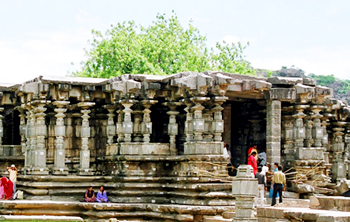 The next phase in the development of the architecture in Chalukyan hybrid form, opening in the first half of the 11th century, is marked by adventurous planning, by more assertive planar variation, and by the introduction of weightier pier-buttresses to the intermediate zone between the side and central projections. Notable above all are the treatment of the superstructure and the use of a wide variety of miniature super structural forms over the aedicule and pier-buttresses. Until the middle of the century these were invariably southern vimanas but then miniature Latina, Sekhari and Bhumija shikharas began to appear as well. To these, moreover, was soon added the hybrid vimana form itself then being developed to full scale by the Chalukyan architects. In the development process of the Chalukyan architecture, the further assertion of the verticals breaks down the autonomy of the storeys in response to the stepped projection of the mass. The capitals of the pier-buttresses in the recessions are repeated at each level between the miniature parapet cells over the corner and central projections, to produce five distinct vertical zones like the Latina shikhara of the north. Moreover, a determined central accent results from the elongation in profile of the central cell gables, suggesting the continuity of their lines though in fact each is stepped back from the one below. Though considerable variety in the combination of circular and square elements continued to enliven the composition of pillars, the circular lathe-turned forms predominate. These developments are well represented at Gadag, Chaudadampur, Haveri, Niralgi and Nilagunda.
The next phase in the development of the architecture in Chalukyan hybrid form, opening in the first half of the 11th century, is marked by adventurous planning, by more assertive planar variation, and by the introduction of weightier pier-buttresses to the intermediate zone between the side and central projections. Notable above all are the treatment of the superstructure and the use of a wide variety of miniature super structural forms over the aedicule and pier-buttresses. Until the middle of the century these were invariably southern vimanas but then miniature Latina, Sekhari and Bhumija shikharas began to appear as well. To these, moreover, was soon added the hybrid vimana form itself then being developed to full scale by the Chalukyan architects. In the development process of the Chalukyan architecture, the further assertion of the verticals breaks down the autonomy of the storeys in response to the stepped projection of the mass. The capitals of the pier-buttresses in the recessions are repeated at each level between the miniature parapet cells over the corner and central projections, to produce five distinct vertical zones like the Latina shikhara of the north. Moreover, a determined central accent results from the elongation in profile of the central cell gables, suggesting the continuity of their lines though in fact each is stepped back from the one below. Though considerable variety in the combination of circular and square elements continued to enliven the composition of pillars, the circular lathe-turned forms predominate. These developments are well represented at Gadag, Chaudadampur, Haveri, Niralgi and Nilagunda.
The Sarasvati at Gadag, the Mukteshvara at Chaudadampur and the Siddharameshvara at Niralgi are similar in plan to the Kalleshvara at Kukkanur apart from the disposition and number of porches. The Siddharameshvara at Havari has three entrances and only the inner corners of the hall adjacent to the vestibule are closed. The three shrines of the Bhimeshvara at Nilagunda open from a central hall with a portico to the fourth side also serving a fourth shrine. Open halls, like porches, have full vedika with seat-back coping and prominent chadyas with padma profile which continue across the vimana. Apart from the wide variety of `lathe-turned` columns, those inside the hall of the Sarasvati shrine at Gadag are related to the multi-faceted Gujarati type, reflecting the bands of ornament of the highly adorned wall. The articulation of closed halls is consistent with vimanas, the inner bays breaking forward from the base plane to much the same degree and as at Kukkanur and Lakkundi these projections are usually all framed by attenuated padma-kumbha pilasters. Weighty pier-buttresses relieve the corners of the first intermediate projections at Niralgi and this feature is given even greater weight at Haveri. Several further lightly projecting planes in the centre are assimilated to house the assertive ghana-dvaras, with their increasing variety of miniature shikharas and vimanas whose prominent chadyas echo those of the structure itself.
Interestingly, the maturity of the architecture of the Chalukya dynasty was achieved at several sites including Hangal, Kuruvatti, Ittagi and Lakkundi. Their temples retain the basic sequence of generous rectangular vestibule and larger nine-square closed hall. In addition there are magnificent cruciform open halls with equilateral projections between the arms of the cross and ceilings as sumptuous as those of the architectural style of Solankis. Fertility of invention in varying the basic theme of the `lathe-turned` order has not flagged and one particularly significant innovation is fluting across all the mouldings. Walls have even greater plasticity than formerly due both to the enhanced depth of projection and to the consistent interpolation of piers in the peripheral recessions. The architectonic lintels are not the later Chalukyan norm. The Gujarati influence in the Chalukyan architecture is well represented by the profusion of base mouldings at Lakkundi and the unsurpassed intricacy of the ceiling in the hall at Hangal.
The Later Chalukyan contribution to Yadava architecture was incidental. On the other hand, Kakatiya work, well represented by the great Thousand-pillared temple of Hanamkonda, is essentially derivative from the Later Chalukyan architecture. Thus, the architecture in Chalukya dynasty is a complete distinctive style highly influenced by both northern and southern architecture of India.
Literature and art of the Chalukya Period
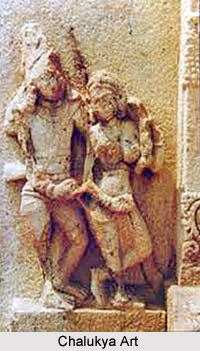 The Chalukya period is important for the development of literature and art. Someprabhacharya, Ramachandra, Udaichandra, Yashapala, Jaya Singh, Vatsaraja. Soddhal, Hemchandra, etc. were the famous scholars who lived in the courts of the Chalukyas kings. Someprabhacharya was the author of `Sumatinath charit` and `Kumarapala pratibhodha`. The Draman of `Maharaja Parjaya` was written by Yashapal. Jaya Singh wrote the famous drama, `Hamir Mada-mardan`, Vatsaraj also wrote six dramas. `Udayan-Sundari` is a famous work of Soddhal. Hem Chandra was the author of `Trishistasashalakaka purush charit`, `Nyasa`, `Dvayashaya`, `Ashtadasasaha Sri`, etc.
The Chalukya period is important for the development of literature and art. Someprabhacharya, Ramachandra, Udaichandra, Yashapala, Jaya Singh, Vatsaraja. Soddhal, Hemchandra, etc. were the famous scholars who lived in the courts of the Chalukyas kings. Someprabhacharya was the author of `Sumatinath charit` and `Kumarapala pratibhodha`. The Draman of `Maharaja Parjaya` was written by Yashapal. Jaya Singh wrote the famous drama, `Hamir Mada-mardan`, Vatsaraj also wrote six dramas. `Udayan-Sundari` is a famous work of Soddhal. Hem Chandra was the author of `Trishistasashalakaka purush charit`, `Nyasa`, `Dvayashaya`, `Ashtadasasaha Sri`, etc.
Many temples were built by the Chalukya kings during this period. These temples clearly illustrate the high development of architecture and sculpture during this period. The Chalukya kings rebuilt the temple of Somanath. Jain temples of this age are very beautiful from the point of view of architecture. The art of painting had made progress during this period. The incidents from the life of Jain Tirthankara were painted on the walls of big buildings. Some paintings of kings are also found. The painting of Karndeva along with Minad Devi needs special mention in this connection.
Thus it can be seen that the Chalukya period is important so far as cultural progress is concerned but, "From the political point of view, the reign of Chalukya`s is of less importance but they have their own importance in the view of culture."
Social condition During Chalukya Rule
The society was divided into four castes, viz., Brahmanas, Kshatriya, Vaishyas and Sudras. Mostly Brahmanas were busy in doing the works like priests, teachers and religious propagators. Mostly the ministers of Chalukyas used to be Brahmans. The Kshatriyas formed the ruling class. The Vaishyas were the traders and had organized themselves into different srenis such as vamika, mahattar and mahajana. The Sudras either served the three castes or did farming. The caste system was very rigid. There had come into being many castes and sub castes.
The ruling class of king and samantas practised polygamy. Marriages within the same gotra were not allowed. Inter-caste marriages were rare. Mostly the marriages were settled by parents but sometimes girls selected their husbands. Women were respected in the society and women could sacrifice everything for the sake of their prestige.
Wheat, rice, barley, meat and wine were the main items of their diet. Sari, kanchuki and a shawl mostly formed the main dress of women. Men usually wore dhoti, turbans, etc. Both men and women, were fond of ornaments.
Dancing dramas, animal fights and wrestling were the main means of amusement of the people. Gambling was also a favourite pastime of the king and royal families.
Education was connected with religion. Temples were the main centers of education where Brahman and Jain acharyas imported education to the students.
Religious condition
Shaiva religion made a great progress during the reign of the Chalukyas. The kings of this period were called `Umapati varlabdh`. The kings of this period built many temples of siva. The broken temples of Somanath was also rebuilt during this period. The construction of `Eka Sahastraling Talaba` and temples on all the four sides of it was also done during this period. Vaishanava religion was also prevalent but there is no as such evidences of this religion.
Buddhism was not a popular religion during this period.. However, Jainism was prevalent and the followers of this religion were increasing in number. Some Jain temples were also built during this period
Economic condition during Chalukyas
Agriculture was the main occupation of the people. Besides Sudras, Brahmans, Kshatriyas and Vaishyas had their own land. Wheat, rice, barley etc. were mostly produced food materials. Among fruits, mangoes and apples were mostly grown.
Besides agriculture, cattle rearing was another common profession. People domesticated cows, buffaloes, horses, goats, etc in an wide sense.
Mostly the trades were in the hands of Vaishyas who had organized themselves into different srenis. There were many trades and industries. During the reign of the Chalukyas silk, ivory, diamonds, pearls and spices were exported in great quantities to foreign countries.
War between Pallavas and Chalukyas
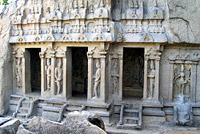 Towards the closing stages of 500 AD, Simha Vishnu undertook the possession of the province, and became the founder of the Pallava dynasty. He fought numerous wars and the realm enjoyed the opulence. Subsequent to his demise, his son Mahendravarman ascended him to the throne. He was a learned man; commenced the work of cave temple at Mahabalipuram.
Towards the closing stages of 500 AD, Simha Vishnu undertook the possession of the province, and became the founder of the Pallava dynasty. He fought numerous wars and the realm enjoyed the opulence. Subsequent to his demise, his son Mahendravarman ascended him to the throne. He was a learned man; commenced the work of cave temple at Mahabalipuram.
Pulakesi II, the most prominent early Chalukya king, learnt about the riches of Kanchi and attacked the kingdom to defeat Mahendravarma. He came with a huge army and overpowered Mahendravarman at Pullalur in 620 A.D. Thus, had whitewashed Mahendravarman and seized diverse northern Pallava provinces. It was an immense offense to the Pallavas and Mahendravarman in particular. The entire episode took a toll on the emperor`s health. His further attempts to take vengeance in a sequence of battles with Pulikesin in the northern part of Tamilnadu were in vain. 630 AD marked the demise of Mahendravarman, as he died a broken man with the insult.
His son Narasimhavarman was a man of tact and intelligence. Narasimhavarman rose to the throne in 630 A.D, and promised to retribute the offense committed onto his father by the Chalukyas. He married the Pandya princess Vanama Devi and later began his invasion towards Vatapi. He led his army along with his general Paranjothi and occupied Vatapi, effectively conquering and killing Pulakesi II in 642, in the Battle of Manimangalam and Pariyalam. He completely burnt the capital city of Pulakesi.
He retorted back to Kanchipuram as a triumphant monarch, and was entitled Vatapikondan (one who destroyed Vatapi). He earned the title "Mamalla" to his acclaim, and perhaps this could be the reason why Mahabalipuram is called Mamallapuram. Badami continued under his authority until 655 AD till Vinayaditya restored it back to the Chalukya realm. Thandi Varman (775 - 825) was a Pallava monarch who ruled in South India. He was the son of Nandivarman II.
Pallavas issued copper coins at Badami, depicting the imperial emblem "Bull to right" on the obverse and "Lotus" symbol on the reverse.



















